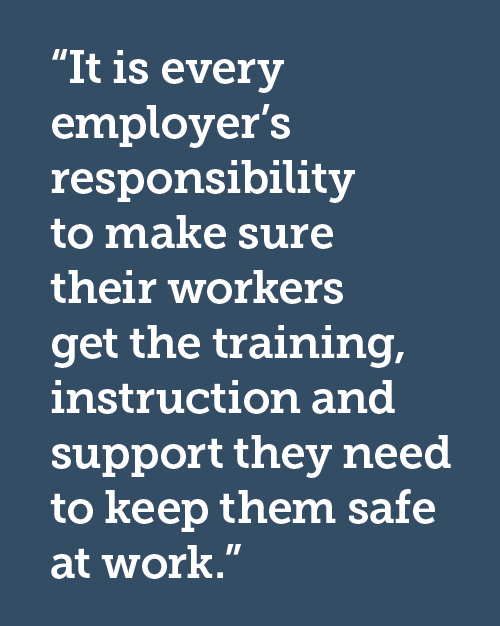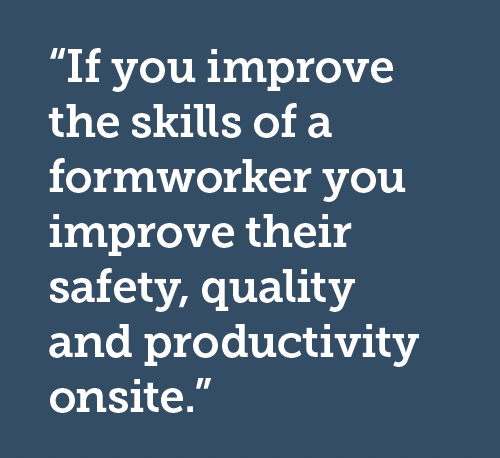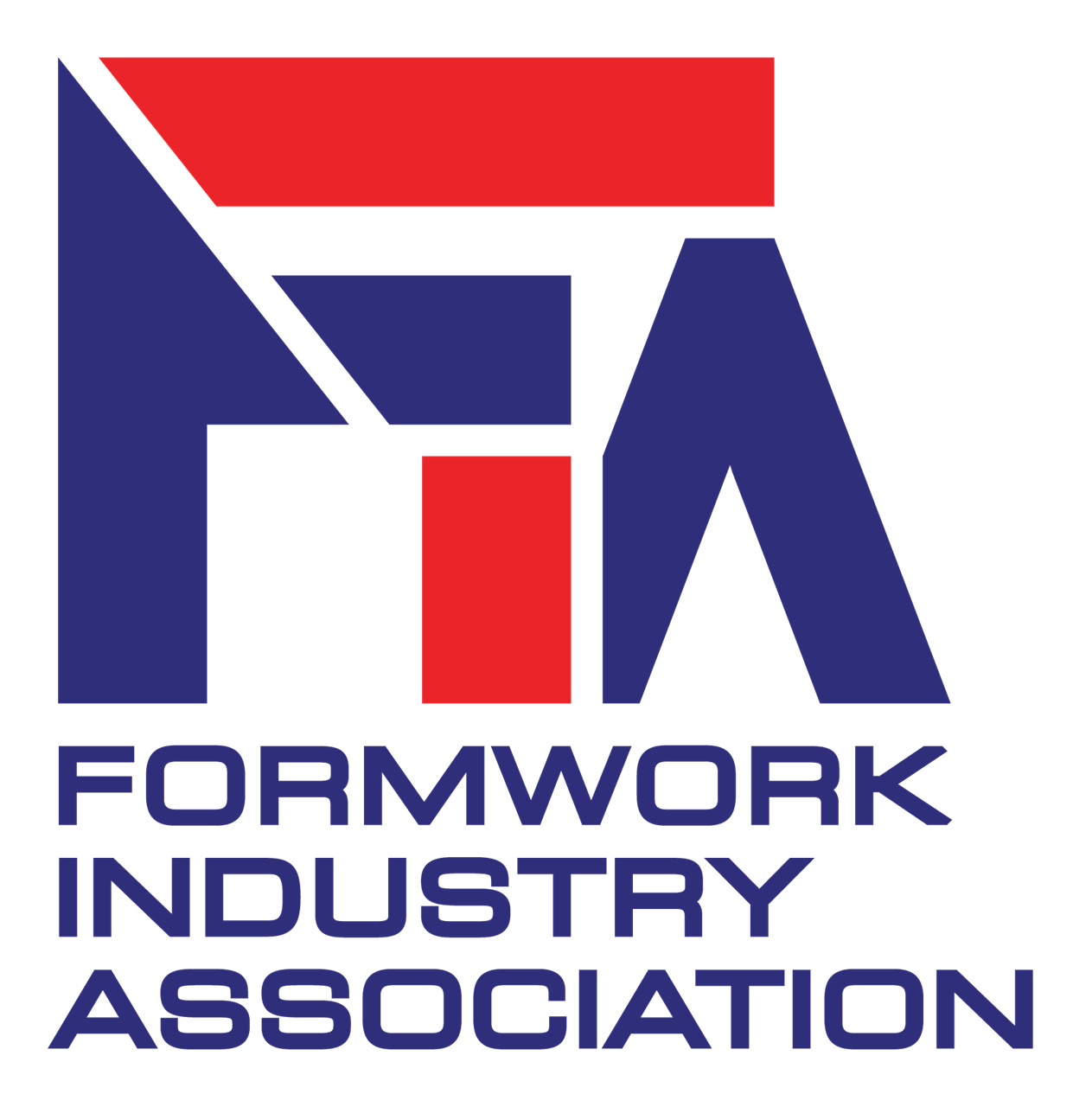Article published in Inside Construction magazine June/July 2023.
Following the recent launch of the new Safe Formworker Program, Michael Sugg delves into the Formwork Industry Association’s plans to develop a new education and skills pathway.
With the launch of the new Safe Formworker Program, featured the June 2023 edition of Inside Construction, and with enrolments increasing by the day, the Formwork Industry Association (FIA) is working with its members to develop a new education and skills pathway. This will take the re-engaged formworker from the Safe Formworker Program to certified training and the new Certificate III in Formwork, currently being discussed by the FIA with Federal Government training bodies. The goal is to develop a ‘fit for purpose’ formwork qualification in preparation for the large number of government infrastructure projects in the pipeline.
History
As you may be aware, the previous Federal Government made the decision to subsume the Formwork & Falsework Certificate III qualification into the Carpentry Certificate III qualification in 2021/22. This took away the only formwork-specific qualification and access to any funding for apprenticeships or funding for recognition of prior learning (RPL) programs, as well as formwork specific education and skills pathways. Whilst the Carpentry Certificate III qualification is ‘fit for purpose’ for those building residential houses, it is not ‘fit for purpose’ for large scale building and infrastructure projects, putting further pressure on the skills shortage and safety in our industry.
Following extensive campaigning at both federal and state levels by the FIA, the Australian Skills Quality Authority (ASQA) agreed to extend the transition period of CPC31511 - Certificate III in Formwork/Falsework until 31 December 2023.
This enabled the formwork industry to continue to employ formwork apprentices and access relevant funding to assist with their wages. It also enabled the industry to access training and demonstrate education and learning targets now required for most government projects to secure future projects and work.
Back in 2022, the Federal Government instructed the FIA to work with consultancy ARTIBUS on a new formwork certification, and together with industry, we drafted a proposed new infrastructure-focused formwork Certificate III qualification. This was going through the necessary approval process until the recent Federal election and now it is ‘stuck’ in government bureaucracy as the new Jobs and Skills Council (JSC) is formed. Registered training organisations (RTOs) and industry have called for an extension to the transition period in view of the delayed formation of the JSC and we are still waiting to hear the outcome.
With high incident levels on sites, a skills shortage and other industry pressures, there is still a need, and demand, for the right level of training and expertise to minimise the level of risk and improve safety on site. Without any formwork specific education and skills pathway, and no need for formworkers to be specifically skilled or licensed to work on site, the formwork industry decided to take control and take the lead to improve safety on construction sites.
New education and skills pathway
Over the past year the FIA, formwork and construction industries have got together to formulate a new Formwork Education and Skills Pathway to improve safety in the Australian formwork industry. Industry feedback requested the FIA create industry wide and recognised minimum levels of safety to get workers safely on site. Feedback also stated that there was a need to re-engage workers in learning and prepare them for future learning/training to address the skills shortage.
 As the Building Confidence report by industry experts Peter Shergold and Bronwyn Weir stated, industry collaboration is a key driver in ensuring future success within the industry and a catalyst for change to occur. The recently released Australian Work Health and Safety Strategy 2023-2033 states that companies need to make sure that, on their projects, there is meaningful and relevant training for workers delivered in a way they can understand. It supports the continuation and strong focus on compliance and enforcement by regulators, with a particular focus on systematic work health and safety (WHS) management. If you don’t have meaningful and relevant training and cannot demonstrate robust WHS management, the risk is that the safety regulators will investigate the quality of your systems, including training and competency, to hold companies and individuals accountable. WHS laws are risk based and don’t need an incident to occur for a business and its individuals to be liable. It is every employer’s responsibility to make sure their workers get the training, instruction and support they need to keep them safe at work.
As the Building Confidence report by industry experts Peter Shergold and Bronwyn Weir stated, industry collaboration is a key driver in ensuring future success within the industry and a catalyst for change to occur. The recently released Australian Work Health and Safety Strategy 2023-2033 states that companies need to make sure that, on their projects, there is meaningful and relevant training for workers delivered in a way they can understand. It supports the continuation and strong focus on compliance and enforcement by regulators, with a particular focus on systematic work health and safety (WHS) management. If you don’t have meaningful and relevant training and cannot demonstrate robust WHS management, the risk is that the safety regulators will investigate the quality of your systems, including training and competency, to hold companies and individuals accountable. WHS laws are risk based and don’t need an incident to occur for a business and its individuals to be liable. It is every employer’s responsibility to make sure their workers get the training, instruction and support they need to keep them safe at work.
In an industry that does not require any more than a White Card to work as a formworker, and with no clear training and skills pathway, it is easy for companies not to be compliant. This is a great opportunity for change to occur and for industry to take the lead – and that’s what it’s doing.
The proposed pathway has been received well in NSW, with support of both the formwork and construction industries, and particularly the NSW Department of Education, which has funded the progress of 1,000 formworkers through the Safe Formworker Program, as the first ‘run’ of the new pathway towards certified training. As we reported last edition, there is a need to re-engage workers in meaningful learning and assist them to develop confidence and an appetite for further training to develop their skills and ultimately their careers.
 There has been no dispute from anyone in the industry when we say, “if you improve the skills of a formworker you improve their safety, quality and productivity on site”. It’s a situation that benefits everyone.
There has been no dispute from anyone in the industry when we say, “if you improve the skills of a formworker you improve their safety, quality and productivity on site”. It’s a situation that benefits everyone.
In the new pathway, a worker can progress their learning from the Safe Formworker Program into a series of relevant formwork-specific micro-credential courses and formwork skills to build learning confidence, and assess workers’ knowledge and competencies. The FIA’s app-based learning tool also allows a worker to build a body of video-based evidence of their competencies on site following these micro-credential courses. This not only improves their knowledge but gives them control and ownership of their training and learning records and allows them to present these to future employers. This makes them more employable and provides a mechanism not currently available for both workers and employers to understand and rate a worker’s skills. It makes recruitment of skilled labour easier and reduces some of the pressures on formwork companies at present. It also allows for companies to be more compliant with record keeping of their workers meaningful and relevant training.

From these micro-credential courses and skills, the FIA and industry have been working with industry training advisory bodies (ITABs) to develop a series of skill sets which include entry-level accredited training on specific units of competency relating to formwork. These skill sets will be delivered by RTOs and funded by the smart and skilled program. The FIA is working closely with RTOs and ITABs to ensure that these skill sets can be delivered in line with industry demand and, where feasible, onsite, to reduce the time a worker spends offsite. While there is still a lot of work to do here, we are confident that these skills sets will meet industry demand and ensure there is a pathway for workers to follow and address the skills shortage.
In an industry that does not require any more than a white card to work, and no need for tickets, you cannot expect a worker to jump straight into a Certificate III training course, or for their employer to encourage this when the cost to them is so high. A pathway is essential. Not only does this assist the worker and allow them to manage their learning and skills progression for a better career, but it also enables the employer to access relevant and meaningful learning for their workers and be compliant under the WHS Act.
The pathway enables a formworker to then choose whether they engage in the Certificate III in Carpentry or, when it is available, the new Certificate III in Formwork for Infrastructure. For the first time we will have a formwork specific education and skills pathway that everyone can recognise.
Safety is an issue on all sites. Skills shortages are an issue in our industry. With an ageing workforce and financial pressures, we are looking at a very bleak future for the Australian formwork industry. The time to act is now.
Details of the Safe Formworker Program and Skills Pathway can be found on the FIA website and industry participants are encouraged to contact Michael Sugg to discuss support on how to achieve the target of 1,000 workers through the program to improve site safety. Please note that given the significant uptake in the program, there are limited places and those will be offered on a first-in basis.
COPY OF ARTICLE
